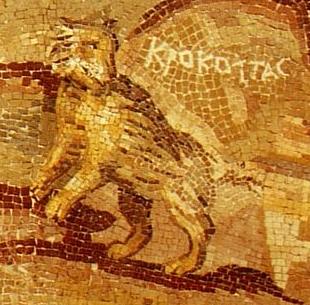At last the Duat piece is done. I made some changes to my original plan, but I'll discuss those in a bit.
I started off by drawing the images I wanted to include in the design. The most challenging was the skeletal version of Ammut, the composite daemon who eats the heats of the unworthy. To create her I broke her down into the three animals she is made up of: a crocodile's head, a lion's shoulders and a hippopotamus' hindquarters. I then found images of the skeletons of each of these animals and created Ammut's skeleton by putting these together.
I wanted her to look threatening and disturbing, so I chose an open-mouthed crocodile skull and a twisted pose.Once I had the images I wanted to use, I made brushes out of them in photoshop and started to work on the image. As I liked the effect of the bleach drawings and the X-ray like quality of the white on black images I had done before, I decided to apply white brushes onto a black background. I started with my central motif: Ammut standing above a heart framed by a structure comprised of snakes and papyrus fronds. I wanted to give the frame an architectural feel similar to the depictions of temples and shrines in the Book of the Dead but to have it made of organic forms.
Once I had the central image sorted, I ensured the design was properly centred, added white guidelines and then a series of snakes at diagonals to add a diamond pattern
To test that the snake diagonals lined up, I tested the image as a pattern
The result had a nicely archaic feel. It reminds me of 18th century wallpaper designs. However it didn't quite capture the sense of threat and fear that I wanted so I added brushes based on dangerous animals common in Egyptian art, especially in images of Duat: scorpions and hippotomi. I considered adding a crocodile, as crocodile daemons are very common but decided that that might detract from the crocodile that made up Ammut's skull.
Originally I tried adding a smaller scorpion but I felt that it didn't make use of the space very well. Once the design was finished, I tested it on a large area once again.
Although the repeat itself is fairly simple, being nothing more than a block repeat, I like the geometric feel that the blocks and diamonds create. Like the first test image, the piece has an old-fashioned feel which suggests the influence that Egyptian art has had on the development on art in the Western world, being the original inspiration for ancient Greek sculpture, relief and painting which is the backbone of Western representational art. Like the original vignettes from the Book of the Dead, it is both elegant and ordered and disturbing.
In my last blog post I wrote that I planned to make a very disordered repeat to hint at the Egyptian fear of chaos, but after looking at the art and literature of the Book of the Dead once more I remembered that Duat is a fairly ordered and linear place, however disturbing. The Book of the Dead acts as a map, showing the deceased the path through Duat to the houses of the Underworld gods, and as such it shows the order there as a person can only reach their goal by following it. Duat is ruled by deities who represent order. Osiris, Anubis, Isis, and Ra all have duties there, but certain daemons are hinted to be sent to attack the deceased by Seth, god of chaos: order rules but chaos has influence. However, to hint at the fear of chaos, I ensured that there was an element of instability in my piece by making diamond shapes different sizes, which tricks the eye and adds a sense of nervousness. I made sure the diagonals continue fluidly through the piece, though, to suggest the path through Duat, with the winding spines of the snakes suggesting the complex journey past the many dangers towards the "climax": the Weighing of the Heart.
I think the white-on-black Duat design would make a good pattern for a statement wallpaper. If reduced in size and printed onto a heavy fabric it would make an interesting, subtle pattern for a skirt. It would be interesting to try printing it black-on-black onto velvet to create a subtle relief pattern, and I think the dark but glossy qualities of black velvet would suit the subject matter and heighten the unsettling feel of the subject matter.
I experimented with changing the colours but I think the white on black scheme is the strongest, adding a modern twist to a design that draws so heavily from the past.
I do quite like the effect on this last one, however,. The blue-tones against the white are suggestive of 18th century porcelain.
















































